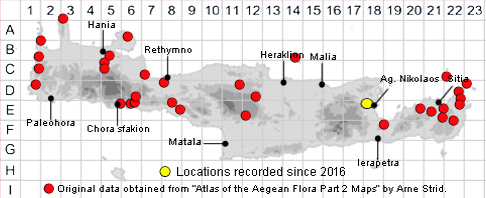
SYMPHYTUM CRETICUM
Family:- BORAGINACEAE
Common Names:- Cretan gorge comfrey
Synonyms:- Borago cretica, Procopiania cretica, Psilostemon creticus,
Trachystemon creticus.
Meaning:- Symphytum (Gr) Growing-together-plant. A name used by the Greek
physician and botanist Dioscorides for healing plants, including comfrey.
Creticum (L) Cretan, from Crete.
General description:- Perennial, more or less branched herb.
Stems:-
a) 15-45 cm.
b) sparingly branched.
c) with patent, rather soft bristles mixed with much smaller hairs especially
above.
Leaves:-
1) Blade:
a) elliptic-ovate, often almost heart-shaped (subcordate).
b) stalked (petiolate).
c) upper stalkless (sessile), extending down the stem (decurrent).
Flowers:-
1) Cymes:
a) many-flowered.
2) Calyx:
a) 4·5-7(-8) mm.
b) lobed to 1/2-4/5.
c) lobes acute.
3) Corolla:
a) blue-violet, rarely white.
b) tube, (2-)2·5-4(-4·5) mm.
c) lobes, 2 1/3 to 4 1/2 times as long as tube, patent, not contorted, only slightly
recurved in the uppermost part.
4) Scales:
a) narrowly lance to awl-shaped (lanceolate-subulate).
b) marginal papillae (small nipple-like projections) not more than 1½ times as
long as wide.
5) Stamens:
a) 9-11(-14) mm.
b) hairless or with minute lateral hairs at the base.
c) without basal scales, or the scales rarely with a minute, unilateral, fringe of
very short hairs.
d) anthers 1·5-3(-3·5) mm.
Fruit:-
1) Nutlets:
a) ovoid.
b) erect, sometimes curved.
c) usually warty (verruculose) and often wrinkled (rugose).
d) concave at the base with a thickened collar-like ring.
Key features:-
1) Corolla-tube 2-4·5 mm.
2) Lobes not contorted.
3) Marginal papillae of corolla-scales not more than 1½ times as long as wide.
Habitat:- Rocky habitats and calcareous cliffs, ledges and fine debris, shady rocky
places. 0-1100 m.
Distribution:- S Greece, S Aegean Is., Crete. Mainly in the E. and W. Of Crete.
Flowering time:- Late Mar to early June.
Photos by:- Fotis Samaritakis
SPECIES DESCRIPTION
